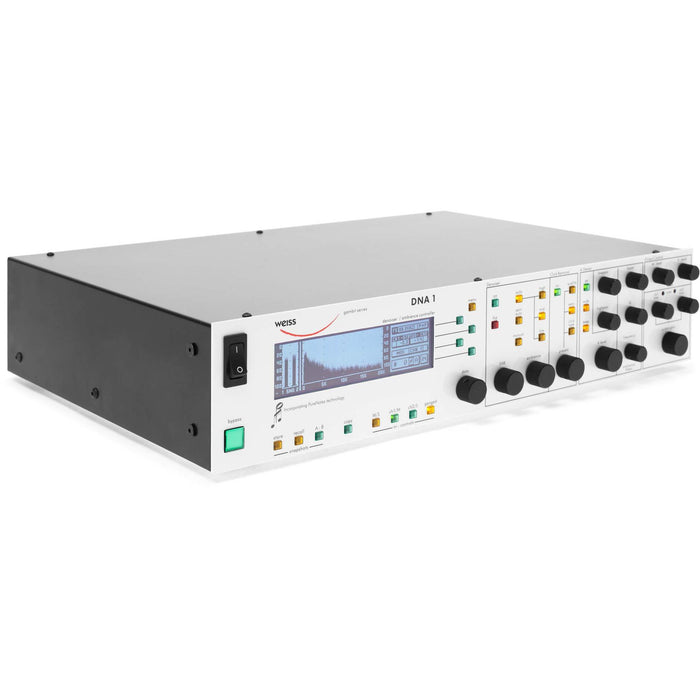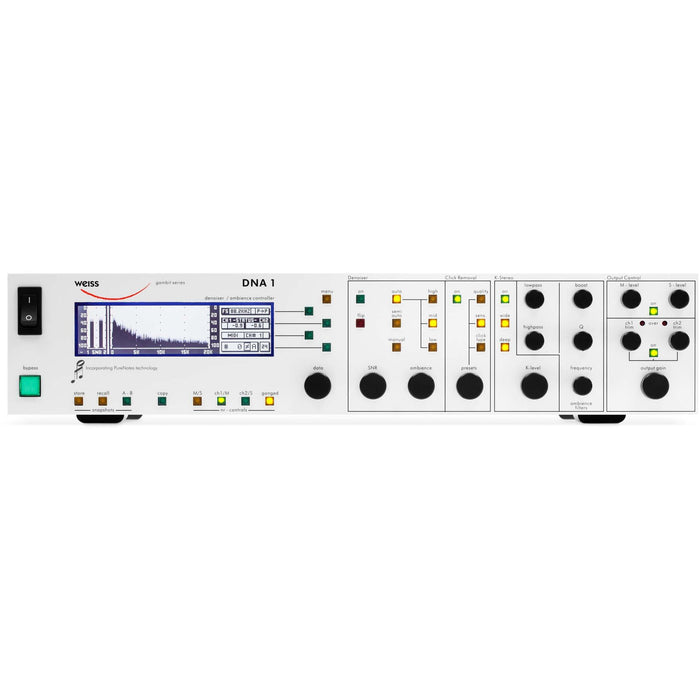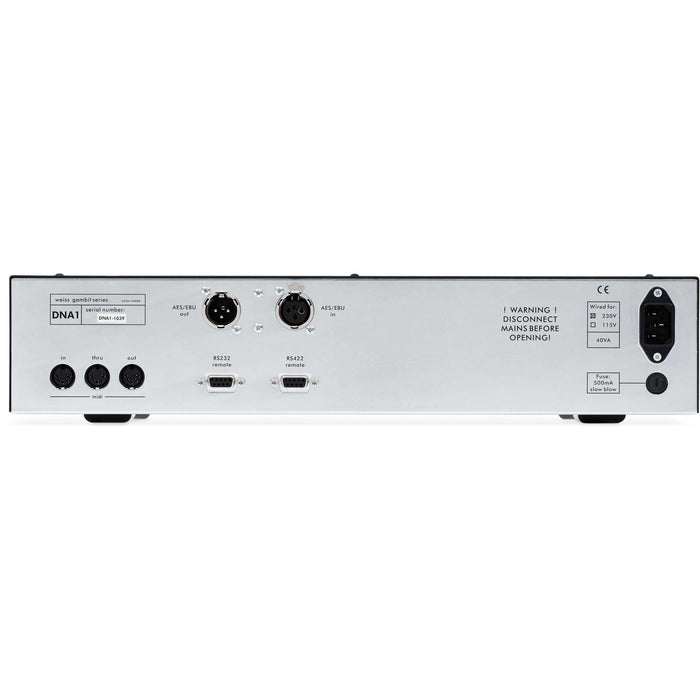
Weiss DNA1 - Two Channel Denoiser, Declicker/Ambience Control
Weiss DNA1 - Two Channel Denoiser, Declicker/Ambience Control
The Weiss DNA1 is an extremely versatile toolbox for restoration work. It handles broadband noise reduction as well as de-clicking and de-crackling. The K-Stereo Ambience Processor brings back life to the music in case it lost some during de-noising, or generates a pseudo stereo signal out of mono. Finally an M/S matrix allows to define the stereo width.
Weiss DNA1 Features
Controls, display
There are a total of 15 knobs in order to almost have a "one knob per parameter" operation. The knobs are touch sensitive to switch the LCD to display the associated parameters. The LCD shows an FFT of the input signal and meters to indicate the amount of de-noising going on. In addition all parameters are shown in numerical format.
Snapshots, MIDI, metering
Other basic features are an A/B compare memory, a 128 position snapshot bank with two additional banks for back-up (can also be dumped/recovered via MIDI), over indicators, MIDI control for each parameter, an overall bypass switch and an overall gain control, a channel ganging switch and an M/S mode switch.
Signal processing, connectivity
The internal processing is done in a 40 Bit floating-point format. Input signals can be between 44.1 and 96 kHz. The output can be POW-R dithered to 16, 20 or 24 Bits. The digital input/output are in AES/EBU format on XLR connectors.
Broadband de-noiser
The broadband de-noiser section works based on an FFT approach with a selectable number of frequency bands. The energy in each band is analyzed and thus determines whether the band is of relevance for the music signal. The de-noiser does not need to take a noise fingerprint, it continually adapts to the noise signature. Three operating modes can be selected, the automatic mode for uncritical de-noising, i.e. for cases where the noise floor is fairly low already and thus the de-noising is not that intrusive. The semi-auto mode where some of the de-noiser’s parameters are estimated first based on the auto-mode and subsequently are refined manually by the user. And finally the fully manual mode where all parameters are accessible, for those cases which require more subtle tuning to get the best result. Like e.g. cases of old recordings with high levels of noise which need a subtle balance between removed noise and noise required to stay such that the "vintage" touch of the recording is kept alive.
De-clicker, de-crackler
The de-clicker section is made up of nine main parameters. There are three groups of three parameters each. Each group, named “quality”, “sensitivity” and “click type”, has a few individually selectable snapshots which allow to zoom in on a particular de-clicking problem at hand. After setting the three snapshots for the three groups, the parameters can be trimmed further individually. With that scheme it is relatively simple to get a result quickly
K-Stereo
The K-Stereo processor uses one main parameter, the K-level, which defines the level of the effect. In addition there is a three band equalizer with low cut, high cut and a parametric center band in peaking mode. The equalizer shapes the audio going through the K-Stereo process. The “wide” and “deep” on/off switches allow for additional shaping of the effect.
Output M/S Matrix
The output section consists of an additional M/S encoding/decoding matrix for final stereo width shaping. In addition left and right channels can be trimmed individually plus finally the volume of the stereo signal can be changed with a single knob.
Specifications
Power
- Mains voltage: 115 V or 230 V with voltage selector
- Fuse rating: 500 mA slow blow
- Power consumption: 40 VA max.
Size
- Depth: 30 cm
- Width: 43,3 cm (19")
- Height: 8,8 cm (2HU)
AES/EBU Input
- Sampling frequencies: 44.1 kHz, 48 kHz, 88.2 kHz, 96 kHz
- Maximum input word-length: 24 Bits
- Channel Status Data: Input accepts professional or consumer format
- Connector: XLR female
AES/EBU Output
- Sampling frequencies: 44.1 kHz, 48 kHz, 88.2 kHz, 96 kHz (always the same as the input)
- Output word-length: 24 Bits
- Connector: XLR male
AES/EBU Channel Status Data
The DNA1 allows to convert the incoming Channel Status Data as follows:
- From Consumer to Professional
- From Professional to Consumer
- Transparent mode, i.e. Channel Status Data is fed forward to the output without any conversion (one exception, see below)


